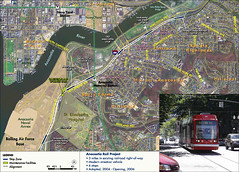Whither Light rail in Anacostia?
 Map of the demonstration light rail/streetcar project in Anacostia, Washington, DC. From the DC Transit Future website.
Map of the demonstration light rail/streetcar project in Anacostia, Washington, DC. From the DC Transit Future website.Last week, the Washington Post ran two articles about the Light rail demonstration project in Anacostia in Washington, DC. In "D.C. Shifts Light-Rail Plan From Waterfront to Streets in SE", it was reported that District transportation officials "want to run a planned light-rail line through neighborhood streets rather than along the Anacostia waterfront because they are unhappy with a deal to purchase land for the project.
District officials had agreed to pay CSX Transportation Inc. $16 million for 2.7 miles of right of way between the foot of the John Philip Sousa Bridge, which carries Pennsylvania Avenue SE, and Bolling Air Force Base.
But city officials said yesterday that a thorough inspection of the property revealed that CSX does not own all of the right of way -- in fact, the District is among the property owners -- raising concerns about what the city was paying for and what it was getting.
Dan Tangherlini, the District's director of transportation, said a detailed analysis "showed us that we weren't really getting what we thought we were getting. We're not getting enough to actually build the line on."
Tangherlini said that the city is willing to fight CSX over the deal and that he believes the line can still be built along its original route, although it probably would not open in fall 2006 as projected. But he said he prefers to shift the line onto city streets, many of which are scheduled to be rebuilt, to bring it closer to the residents and businesses that would use it and to get it running by next year."
Sunday's paper included "Light-Rail Plan Irks Anacostia Residents" which quotes residents criticizing this proposal, seeing very little benefit to them from having greater transportation access and connection to the city. Many of the quotes see the streetcar proposal as benefiting institutions like the Bolling Air Force base, and not area residents.
 Dedicated light rail line in Barcelona. Photo courtesy of John Norquist.
Dedicated light rail line in Barcelona. Photo courtesy of John Norquist.To me, greater transportation access and connectivity is the name of the game. While a dedicated rail line does offer greater speed, greater streetcar access within Anacostia is likely to yield great benefits to the residents, far more than a dedicated line more oriented to serving the business clusters outside of Historic Anacostia and the sputtering business district along Martin Luther King Avenue SE.
Getting back to "Active Citizenship" a la the previous blog entry, citizens have fundamental rights to participate, but at the same time if belief in democracy means that "the people have the capacity to discern, to produce and deploy resources, and to create rules--'policies'--that honor the tension between the parts and the whole" then there must be a commitment to learn and consider not just to react.
_______
From the article:
"It's not fair when we're trying to get economic development here and you tear up our streets," said Lendia Johnson, an Advisory Neighborhood Commission member. "We have so much traffic already. Trying to get down Martin Luther King Avenue is like trying to cross the Jordan River."
Dan Tangherlini, the District's transportation director, acknowledged that officials do not know what impact a light-rail system would have on the community. Officials have studied similar operations in Portland, Ore., and Tacoma, Wash., where, they said, such trains have been a success. The idea, Tangherlini said, is to transport residents within the ward. Previously, he added, the city had concentrated mostly on moving people between the District and neighboring suburbs. Tangherlini said the train cars are longer but thinner than city buses and can make turns on narrow streets more easily than buses....
Community leaders said they worry that the light-rail line will be a greater benefit for workers at nearby Bolling Air Force Base or the Navy Yard than for those who live in Ward 8. "It comes down to one question that has not been answered: What is the economic development impact for Ward 8?" said Jackie Ward, who lives in the community. "I see it for the Navy Yard and Bolling, but I do not see the economic impact for Ward 8." Maurice Perry, a member of East of the River Community Development Corp., said any light-rail system would "need to maintain parking on the street for the small-business owners."
Tangherlini, who said similar light-rail lines could be brought to more than 35 miles of city streets, said he chose to put a light-rail system in Ward 8 in response to criticism that major city projects do not take place east of the Anacostia River. He told the crowd that transportation officials will hold additional community meetings before making any final decisions.
"I thought it would be a good message to keep this here," Tangherlini said. "But if folks really, really, really don't want it, that's a message we'll take away, and we'll see if somebody else wants it."



0 Comments:
Post a Comment
<< Home